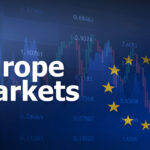EURUSD pair continued to tread water on Thursday after suffering a brutal 2.5% weekly drop. A hawkish Federal Reserve stance and strong US economic data propelled the US Dollar to fresh multi-week highs, overshadowing a modest recovery attempt by the Euro. As of European trading hours, the pair hovered near 1.1450, still reeling from a drop to 1.1400, the lowest since early June.
The recent resilience of the US economy and the Fed’s firm tone on monetary policy have decisively shifted market sentiment in favor of the Greenback. Meanwhile, euro traders are digesting a slew of mixed economic data, particularly the softer-than-expected German CPI, which highlighted waning inflationary pressures in the Eurozone’s largest economy.
US GDP Stuns Markets; Fed Holds Rates
The highlight of the week Wednesday’s release of the US Q2 GDP data. The American economy grew at an annualized pace of 3%, beating all estimates and sharply rebounding from the 0.5% contraction in Q1. Markets expected a 2.4% reading. This surprise surge reinforced the Fed’s cautious position, validating its decision to keep interest rates steady in the 4.25%-4.50% range.
Chair Jerome Powell’s post-meeting remarks added to the hawkish sentiment. While acknowledging uncertainty around the full impact of Trump’s tariffs, Powell emphasized that the Fed needs “more time” to evaluate inflation trajectories. This statement alone triggered a broad repricing in rate expectations odds of a September cut dropped from 63% to 43%, and full-year rate cut expectations fell from 50 bps to just 35 bps.
US Dollar Rallies Broadly, Especially Against the Yen
The Greenback’s strength broad-based. A look at the USD heat map reveals the Dollar posted solid gains across the G10 complex, particularly against the Japanese Yen (+0.33%) and British Pound (+0.18%). The Dollar Index (DXY) rose to its highest level since May, as traders adjusted to the Fed’s message and strong macro prints.
Further bolstering the USD’s appeal were upbeat employment signals. The ADP private payrolls report showed a 104,000 job increase in June, beating expectations of 78,000 and reversing the prior month’s loss. With such robust data, the Fed is now in no rush to deliver stimulus making the Dollar an attractive buy.
EURUSD Weakens on Softer German CPI, Stagnant Labor Market
The Euro failed to find any meaningful support from domestic data. Germany’s preliminary July CPI came in at 1.8% y/y, below June’s 2% and market expectations. While monthly inflation rose to 0.4%, the annual slowdown signals diminished pricing pressures—potentially complicating the European Central Bank’s (ECB) path forward.
Labor market data offered little help either. Germany’s unemployment rate held at a record low of 6.2% in June, which was revised slightly down from 6.3% in May. The figure reflects employment stability but offers no compelling reason for rate hawks to push ECB tightening in the near term.
In Italy, CPI data echoed a similar tone. Headline inflation slowed to 1.7% from 1.8% in June, missing forecasts for a sharper deceleration to 1.6%. Monthly inflation fell by 1%, but this was already expected. Overall, these CPI prints signal cooling consumer prices across the Eurozone, which could reinforce the ECB’s cautious stance in the upcoming meeting.
PCE Inflation in Focus Before NFP Showdown
All eyes are now on Thursday’s US PCE Price Index releasearguably the Fed’s preferred inflation gauge. Market consensus expects annual PCE to remain sticky above the central bank’s 2% target, further justifying the Fed’s reluctance to ease.
If the report prints hotter than expected, EURUSD could face renewed downward pressure, potentially revisiting the 1.1400 level or even lower. Conversely, any signs of disinflation might give the Euro temporary breathing room, although such a move may be short-lived ahead of Friday’s Nonfarm Payrolls (NFP) report.
The NFP expected to show continued strength in the US labor market. If job growth meets or beats forecasts, it will reinforce the narrative that the US economy remains far ahead of its European counterparts, and the USD rally could extend.
Trade Developments Add Tailwinds to USD
The improvement in the US’s trade posture is another layer supporting the Greenback. Fresh agreements with South Korea, Japan, and the European Union have reduced trade uncertainty. These deals are perceived as more favorable to the US, strengthening confidence in future economic performance.
While not yet fully priced into EURUSD, these developments create a geopolitical backdrop that tilts in favor of the US Dollar, especially ahead of the August 1 deadline for Trump’s tariffs.
EURUSD Technical Levels to Watch
Support Level
1.1400 Multi-week low; psychological level
1.1370 May swing low
1.1320 Key Fibonacci support
Resistance Level
1.1460 Immediate cap
1.1500 Psychological barrier
1.1565 200-day moving average
Short-term momentum remains negative, with the RSI still below 50 and bearish crossovers forming on the hourly charts.
Conclusion
As someone with three years of hands-on experience in the financial markets, particularly in forex analysis, I view the current EURUSD trajectory as structurally bearish in the short term. The Euro caught in a bind softening inflation in core economies like Germany and Italy diminishes the ECB’s ability to hike rates further, while the Fed’s steady hand in the face of strong growth data adds to USD demand.
Unless we see a notable rebound in Eurozone data or an unexpected dovish pivot from the Fed (which looks unlikely), EURUSD appears poised to revisit lower levels. A sustained break below 1.1400 could expose the 1.1320–1.1280 region next.
Disclaimer: This blog is for informational purposes only and does not constitute financial advice. Always conduct your own research and consult a professional advisor before making investment decisions.
[sc_fs_multi_faq headline-0=”h2″ question-0=”Why did the EUR/USD fall this week?” answer-0=”The pair fell due to strong US GDP data, a hawkish Fed stance, and weaker-than-expected Eurozone inflation figures, particularly from Germany.” image-0=”” headline-1=”h2″ question-1=”What is the importance of the US PCE Price Index?” answer-1=”It’s the Fed’s preferred inflation measure. Sticky or rising PCE would reduce the likelihood of rate cuts, supporting the USD.” image-1=”” headline-2=”h2″ question-2=”How did German CPI affect the Euro?” answer-2=”Softer-than-expected CPI data from Germany showed easing inflation, which reduces pressure on the ECB to maintain a hawkish stance, weighing on the Euro.” image-2=”” count=”3″ html=”true” css_class=””]









